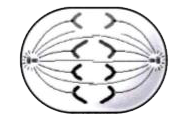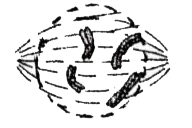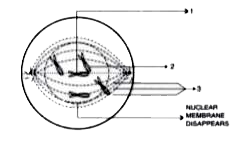Meiosis and mitosis are found to be the two types of cell division . A cell is observed to have 50 chromosomes in its nucleus during interphase before entering S-phase . How many chromosomes will it have after undergoing division by the two - division process ?
1
2
3
4
The correct Answer is:D
To solve the question regarding the number of chromosomes after a cell undergoes meiosis and mitosis, we can follow these steps:
1. Identify the Initial Number of Chromosomes:
- The cell is observed to have 50 chromosomes during interphase before entering the S-phase.
2. Understand the S-phase:
- The S-phase is where DNA replication occurs. This means that the number of chromosomes will double because each chromosome is replicated into two sister chromatids.
- After the S-phase, the cell will have 100 chromatids, but the number of chromosomes remains 50 because chromosomes are still counted as a single unit until they are separated during cell division.
3. Mitosis Process:
- Mitosis is an equational division, meaning that the daughter cells will have the same number of chromosomes as the parent cell.
- Therefore, after undergoing mitosis, the two daughter cells will each have 50 chromosomes.
4. Meiosis Process:
- Meiosis is a reductional division, which means that the number of chromosomes is halved.
- Starting with the original 50 chromosomes, after meiosis, the daughter cells will each have 25 chromosomes.
5. Final Count After Both Divisions:
- After undergoing both processes (mitosis and meiosis), we can summarize:
- Mitosis results in two daughter cells with 50 chromosomes each.
- Meiosis results in four daughter cells with 25 chromosomes each.
Conclusion:
- The answer to the question is that after undergoing division by the two-division process (meiosis and mitosis), the cell will have:
- Mitosis: 50 chromosomes
- Meiosis: 25 chromosomes
Answer:
- The correct option is (4, 25, 50).
- The cell is observed to have 50 chromosomes during interphase before entering the S-phase.
- The S-phase is where DNA replication occurs. This means that the number of chromosomes will double because each chromosome is replicated into two sister chromatids.
- After the S-phase, the cell will have 100 chromatids, but the number of chromosomes remains 50 because chromosomes are still counted as a single unit until they are separated during cell division.
- Mitosis is an equational division, meaning that the daughter cells will have the same number of chromosomes as the parent cell.
- Therefore, after undergoing mitosis, the two daughter cells will each have 50 chromosomes.
- Meiosis is a reductional division, which means that the number of chromosomes is halved.
- Starting with the original 50 chromosomes, after meiosis, the daughter cells will each have 25 chromosomes.
- After undergoing both processes (mitosis and meiosis), we can summarize:
- Mitosis results in two daughter cells with 50 chromosomes each.
- Meiosis results in four daughter cells with 25 chromosomes each.
- The answer to the question is that after undergoing division by the two-division process (meiosis and mitosis), the cell will have:
- Mitosis: 50 chromosomes
- Meiosis: 25 chromosomes
- The correct option is (4, 25, 50).
Similar Questions
A plant cell has 12 chromosomes at the end of mitosis. How many chromosomes would it have in the G2 phase of its next cell cycle
View SolutionGiven below is a diagram representing a stage during the mitotic cell division। Study the diagram and answer the following questions :

How many chromosomes will each daughter cell have after the completion of the above division ?
View SolutionHow many chromosomes will the cell have at G1,after S and after M-phase respectively if it has 14 chromosomes at interphase
View SolutionA cell having 2n = 20, chromosomes with 2C amount of DNA, is undergoing mitosis, what will be the number of chromosomes and amount of DNA during G1 S and G2 phases respectively?
View SolutionGiven below is a diagram representing a stage during mitotic cell division.
Study it carefully and answer the questions that follow:

How will you differentiate between mitosis and meiosis on the basis of the chromosome number in the daughter cells?
View SolutionA Mitosis produces two identical daughter cell.
B Meiosis introduces variation due to gene exchange or recombination.
C During anaphase chromosome have two chromatids.
D Telophase I may be absent.
Choose the option with the correct statements.
View SolutionOnion root tip cells have 16 chromosomes in each cell. Can you tell how many chromosomes will the cell have at G1 phase, after S phase, and after M phase? Also, what will be the DNA content of the cells at G1, after S, and at G2. If the content after M phase is 2C ?
View SolutionThe resistance of 0.5M solution of an electrolyte in a cell was found to be 50Ω. If the electrodes in the cell are 2.2cm apart and have an area of 4.4cm2 then the molar conductivity (in Sm2mol−1) of the solution is
View SolutionGiven below is a diagram representing a stage during mitotic cell division in an animal cell:

Mention two points of difference between 'mitosis' and 'meiosis' with regard to :
The number of daughter cells formed.
The chromosome number in the daughter cells.
View SolutionA galavanometer, whose resistance is 50 ohm has 25 divisions in it. When a current of 4×10−4 A passes through it,its needle (pointer) deflects by one division. To use this galvanometer as a volmeter of range 2.5V, it is should be connected to a resistance of :
View Solution